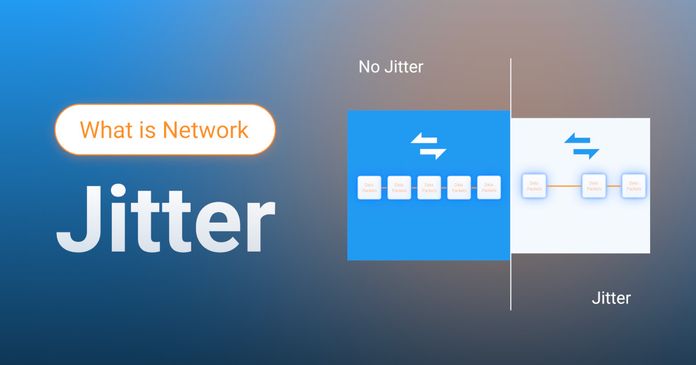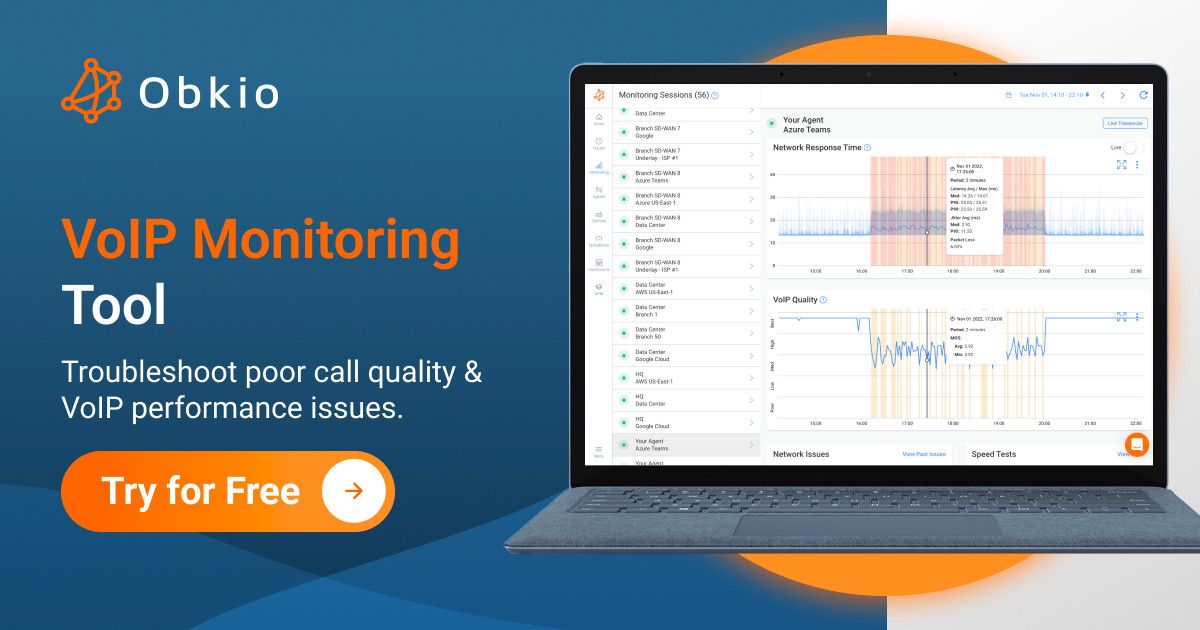Table of Contents
Table of Contents
VoIP jitter is the variation in packet arrival time during voice calls, measured in milliseconds. When voice packets travel across your network at inconsistent intervals; some arriving faster, others slower—you experience jitter. Acceptable jitter for VoIP is 30 milliseconds or less. Above this threshold, you'll notice choppy audio, robotic voices, delays, and call drops that disrupt business communication.
This article shows you how to identify jitter in your network, understand what causes it, measure it accurately, and implement fixes that restore crystal-clear VoIP quality. Whether you're troubleshooting choppy Teams calls, diagnosing Zoom audio issues, or monitoring VoIP performance across your organization, you'll learn detailed steps to eliminate jitter and maintain professional call quality.
What you'll learn:
- How to measure jitter and interpret results (acceptable ranges: <30ms excellent, 30-50ms marginal, >50ms problematic)
- Root causes including network congestion, packet loss, wireless interference, and QoS misconfigurations
- Step-by-step troubleshooting using network monitoring tools to pinpoint jitter sources
- Proven fixes: QoS implementation, jitter buffer optimization, bandwidth management, and network upgrades
- How to monitor VoIP quality using MOS scores to prevent jitter before users complain
VoIP jitter refers to the variation in the delay of received voice packets in a Voice over Internet Protocol (VoIP) communication system. In simpler terms, it represents the irregular timing or spacing between audio packets as they traverse the network from the sender to the receiver.
In a VoIP call, voice data is broken down into small packets and transmitted over the Internet. Jitter occurs when these packets experience varying levels of delay or arrive out of sequence at the destination. This variability in packet arrival times can lead to disruptions in the audio quality of the call, resulting in jitter-related issues such as choppy or distorted voice.
Jitter can be particularly problematic in real-time communication applications like VoIP, where maintaining a consistent and low-latency connection is crucial for a natural and fluid conversation.


Voice over Internet Protocol (VoIP) is a technology that allows voice communication and multimedia sessions over the Internet. Instead of traditional analog telephone lines, VoIP converts voice signals into digital data and transmits it over the Internet in the form of packets.
Jitter is the variation in the arrival time of voice packets during their journey across the Internet. These packets, containing audio data, are transmitted in real-time from the sender to the receiver. Jitter disrupts the regularity of packet arrival, leading to an inconsistent flow of voice data and, consequently, a degraded call quality.
Understanding the causes of VoIP jitter is crucial for effective troubleshooting and mitigation. Several factors contribute to the occurrence of jitter in VoIP communications:
Learn what network jitter is, how it affects VoIP & video calls, and proven methods to measure and reduce jitter in your network
Learn more

One of the primary contributors to jitter is network congestion. When the network experiences high traffic, voice packets may encounter delays as they navigate through routers and switches. This congestion-induced delay results in irregular packet arrival times, leading to jitter.
Packet loss, where data packets fail to reach their destination, is another significant cause of jitter. When voice packets are lost in transit, the receiving end must compensate for the missing data, causing disruptions in the audio stream.
Latency refers to the time it takes for data to travel from the sender to the receiver. Variations in latency, known as latency jitter, can occur due to route changes, network fluctuations, or other unpredictable factors. Inconsistent latency leads to uneven packet arrival times and contributes to jitter in VoIP calls.
Misconfigurations within the network, such as improper Quality of Service (QoS) settings, can exacerbate jitter. Inadequate bandwidth allocation or prioritization for VoIP traffic may result in delays and variations in packet arrival times.
In environments relying on wireless connections, interference and signal fluctuations can introduce jitter. Wireless networks are susceptible to external factors like electronic devices and physical obstacles, impacting the consistency of data transmission.
By unravelling the causes of VoIP jitter, we lay the groundwork for effective diagnosis and mitigation strategies. In the subsequent chapters, we will explore how to monitor and troubleshoot jitter, ensuring a smoother and more reliable VoIP communication experience.
Enhance your VoIP communication experience with Obkio's Network & VoIP Monitoring tool. Seamlessly designed to diagnose, monitor, and troubleshoot VoIP jitter, our tool empowers you to ensure crystal-clear conversations.
With Obkio's VoIP monitoring feature, you can measure VoIP quality using the MOS score and proactively identify and troubleshoot VoIP issues, like VoIP Jitter, before they even affect your users. Obkio's user-friendly interface and real-time monitoring make it easy to keep your VoIP system running smoothly and ensure the best possible call quality.

Here's how Obkio can make a difference:
Real-time Jitter Monitoring:
- Gain instant insights into jitter levels during your VoIP calls.
- Visualize real-time data to identify fluctuations and potential disruptions.
Proactive Issue Detection:
- Detects jitter issues before they impact call quality.
- Receive alerts and notifications to stay ahead of potential problems.
Detailed Analysis and Reporting:
- Dive deep into comprehensive reports on jitter trends.
- Analyze historical data to understand patterns and optimize network performance.
User-Friendly Interface:
- Navigate our intuitive interface with ease, even for non-technical users.
- Access actionable insights without the need for extensive network expertise.
Effective Troubleshooting:
- Leverage network troubleshooting tools to identify and resolve jitter-related issues.
- Empower your IT team with the right resources to ensure uninterrupted VoIP communication.
Don't let jitter disrupt your conversations. Take control with Obkio's Network Performance Monitoring tool. Sign up now for a smoother, more reliable VoIP experience.

VoIP jitter is typically measured using typical jitter measurements, which are expressed in milliseconds (ms). Jitter measurement involves assessing the variation in the delay of received voice packets over a specific period of time. The goal is to quantify how much the packet arrival times deviate from the expected or average delay.
1. Packet Timestamps:
VoIP devices, such as phones or softphones, attach timestamps to each voice packet at the time of transmission. These timestamps provide information about when the packet was sent.
2. Packet Arrival at the Destination:
When the voice packets reach their destination (e.g., another phone or VoIP gateway), the receiving device records the time of packet arrival.
3. Calculation of Interarrival Times:
The difference between the timestamp of a received packet and the timestamp of the previous packet is calculated. This difference represents the interarrival time.
4. Jitter Calculation:
Jitter is then calculated as the variance or average deviation of these interarrival times over a specific time interval.
Mathematically, jitter (J) is often expressed using the formula:

Jitter is presented in milliseconds (ms), representing the average or maximum deviation in arrival times.
5. Monitoring Tools:
Network performance monitoring tools, designed for VoIP systems, often provide real-time and historical jitter measurements. These tools may present jitter values on graphical interfaces, making it easier for administrators to monitor and identify potential issues.
6. Quality of Service (QoS) Metrics:
Jitter is one of the key metrics used in Quality of Service (QoS) assessments for VoIP. Network administrators use QoS parameters, particularly, QoS for VoIP and jitter, to ensure a satisfactory user experience.
Measuring jitter is crucial for maintaining VoIP call quality. By regularly monitoring jitter levels, network administrators can identify potential issues, troubleshoot problems, and implement optimizations to ensure a smooth and reliable VoIP communication experience.
So, how can you do that? Let’s get into that next!
When you’re measuring VoIP jitter, it’s important to understand how much jitter is acceptable for VoIP, and how much jitter is going to drastically affect your VoIP Quality. If you’re using a Network Monitoring tool like Obkio, your tool will notify you when your VoIP jitter levels are too high. You can also set thresholds of your own, and Obkio will notify you when your VoIP jitter measurements have exceeded those thresholds.
But, it’s still important to understand VoIP jitter measurements, and what is acceptable to ensure the smoothest VoIP experience.
- Excellent: < 20ms
- Good: 20-30ms
- Acceptable: 30-50ms
- Poor: 50-100ms
- Unacceptable: > 100ms
Determining what constitutes an acceptable jitter for VoIP involves considering the specific requirements of the application and the tolerance levels of the users. As a general guideline:
Threshold for Acceptable Jitter:
- For most VoIP applications, an acceptable level of jitter typically falls within the range of 20 to 50 milliseconds.
- This range ensures that the variation in packet arrival times is minimal, resulting in good call quality without noticeable disruptions.
Factors Influencing Acceptability:
- The nature of the VoIP application and the sensitivity of the users play a role in defining acceptable jitter.
- In situations where VoIP is used for casual conversations or non-critical communication, slightly higher jitter levels (up to 50 milliseconds) may still be acceptable without significantly affecting the user experience. ### II. Identifying High VoIP Jitter
While acceptable jitter levels provide a smooth communication experience, high levels of jitter can lead to noticeable disruptions and degradation in call quality.
High VoIP Jitter Threshold:
- Jitter levels exceeding 50 milliseconds are generally considered high and may lead to choppy or distorted audio.
- In professional or business environments, where communication clarity is crucial, a jitter level exceeding 50 milliseconds is likely to be perceived as problematic.
The Impact of High VoIP Jitter on Call Quality:
- High levels of jitter can result in more pronounced disruptions, including audio artifacts, out-of-sequence packets, and potential call drops.
- In critical applications like emergency services or high-security environments, even lower levels of jitter may be targeted to ensure the highest standards of communication reliability.


Determining how much jitter is considered "bad" for VoIP involves evaluating the impact on call quality and the user experience. The acceptable threshold for jitter is influenced by the specific requirements of the VoIP application, the nature of the communication, and user expectations.
1. Threshold for Acceptable Jitter: Generally, jitter levels below 30 milliseconds are considered acceptable for VoIP applications. In scenarios where communication clarity is crucial, aiming for even lower jitter levels, around 20 milliseconds or less, may be desirable.
2. When Does Jitter Become Problematic?: Jitter becomes problematic or "bad" for VoIP when it exceeds acceptable thresholds and starts to impact call quality. As jitter increases, users may experience choppy or distorted audio, delays in conversation, and potential call drops.
3. Factors Influencing Jitter Perception:
- The perceived impact of jitter varies based on factors such as the sensitivity of users, the nature of the communication, and the importance of call clarity.
- In professional environments, such as business or healthcare, where precise communication is vital, even minor increases in jitter may be considered problematic.
Application-Specific Requirements:
- Different VoIP applications may have varying requirements for jitter based on their intended use. For example, a casual consumer VoIP application might tolerate slightly higher jitter levels compared to a mission-critical enterprise VoIP system.
User Expectations:
- Understanding user expectations is crucial in defining jitter requirements. User tolerance for disruptions in communication may vary, and VoIP systems should aim to meet or exceed these expectations.
Quality of Service (QoS) Considerations:
- VoIP jitter requirements are often addressed through Quality of Service (QoS) measures. By prioritizing VoIP traffic and ensuring adequate network resources, QoS mechanisms help maintain low jitter levels.
Network Optimization:
- Optimizing the network infrastructure is essential for meeting VoIP jitter requirements. This includes addressing issues such as network congestion, packet loss, and latency.
In summary, determining how much jitter is considered "bad" for VoIP involves aligning with acceptable thresholds, considering application-specific requirements, understanding user expectations, and implementing effective mitigation strategies. VoIP systems should aim to deliver a communication experience that meets or exceeds these criteria for optimal call quality and user satisfaction.
Learn how to measure VoIP Quality using MOS Score (Mean Opinion Score) & Obkio’s VoIP monitoring solution to identify poor VoIP Quality issues & dropped calls.
Learn more

Jitter is a problem that you can usually hear - but it’s hard to see. It’s especially hard to see it coming if you don’t have the right tools.
That’s why Network monitoring tools designed for VoIP Monitoring play a crucial role in mitigating the challenges posed by jitter. These tools offer a comprehensive suite of features aimed at monitoring, diagnosing, and troubleshooting jitter-related issues.
- Real-time Jitter Monitoring: Network monitoring tools provide real-time insights into jitter levels during ongoing VoIP calls. Administrators can monitor jitter metrics and detect deviations instantly, allowing for proactive measures to maintain call quality.
- Historical Analysis: These tools maintain historical data on jitter trends over time. By analyzing historical patterns, administrators gain insights into long-term performance, helping them identify recurring issues and implement preventive measures.
- Alerts and Notifications: Network monitoring tools can be configured to generate alerts and notifications when jitter levels exceed predefined thresholds. Prompt alerts empower administrators to respond swiftly, addressing issues before users experience a decline in call quality.
- Detailed Reporting: Robust reporting features provide administrators with detailed analytics on jitter metrics. Customizable reports offer in-depth visibility, facilitating targeted troubleshooting and optimization efforts.
- Integration with QoS Metrics: VoIP jitter monitoring tools often integrate with broader Quality of Service (QoS) metrics. This integration enables administrators to assess overall network health, identify potential bottlenecks, and prioritize VoIP traffic for optimal performance.
So let’s teach you how to get started!
Jitter is a network problem that you can hear - mostly because it makes you sound like a robot during VoIP calls. But, it’s still important to continuously measure jitter in your network to determine where it’s coming from and what’s causing it.
The most accurate way to test jitter is by using a tool like Obkio Network Performance Monitoring Software.
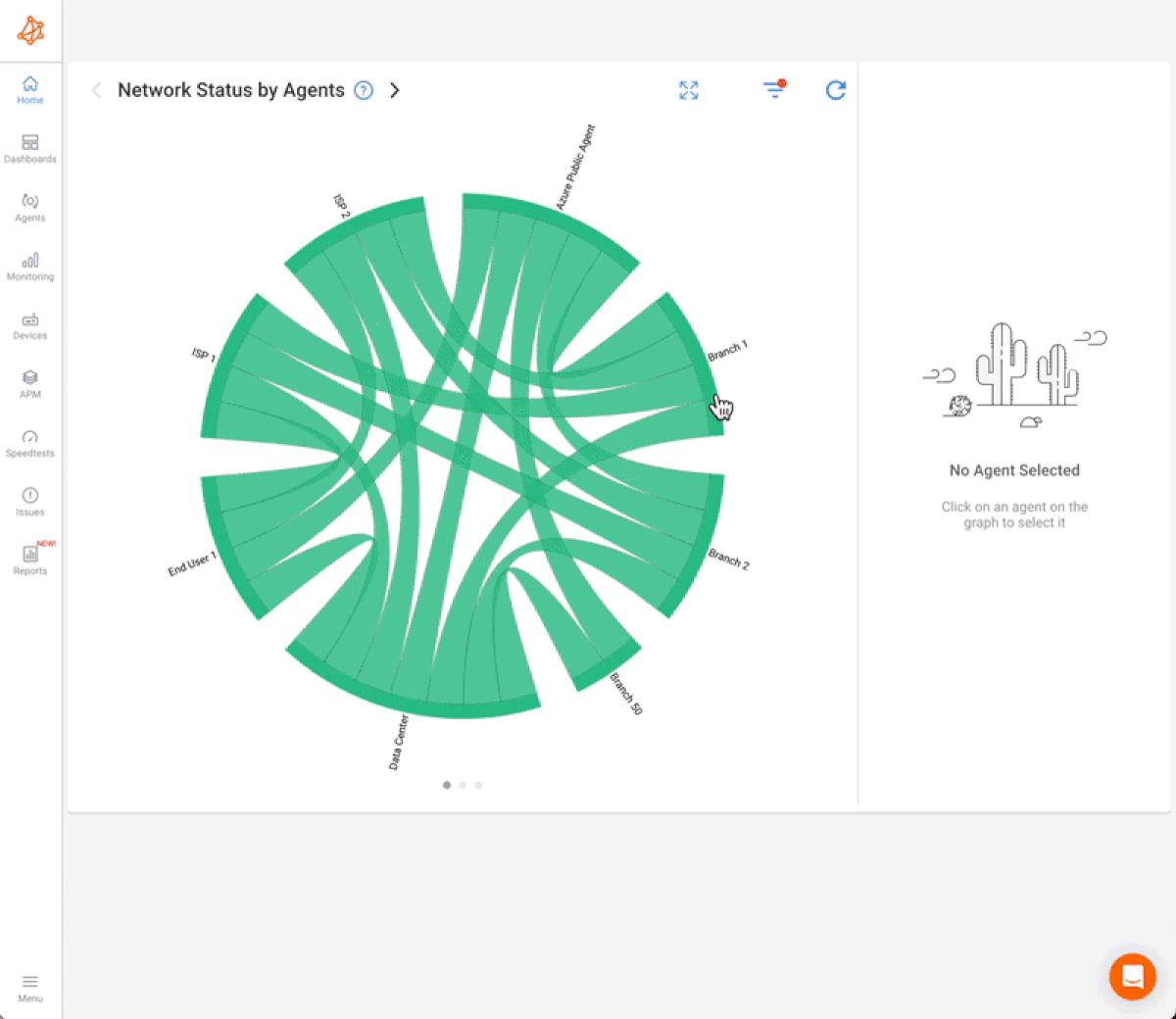
Obkio stands out as an advanced network performance monitoring tool crafted to consistently identify and troubleshoot network jitter anywhere in your network. By sending and monitoring synthetic traffic at 500 ms intervals (equivalent to half a second), Obkio can more effectively identify VoIP Jitter, where precise timing is imperative.
The 500ms packet transmission interval enables Obkio to detect any deviations in delay or packet loss that might impact the performance of VoIP or UC applications. The gathered data serves as the foundation for calculating essential metrics, including jitter, essential for sustaining an optimal network environment.
Obkio's comprehensive approach extends beyond mere jitter monitoring, presenting a holistic perspective on network performance. This multifaceted solution proves potent in addressing issues related to jitter. This all-encompassing network monitoring tool not only pinpoints variations in jitter but also furnishes valuable insights into network congestion, packet loss, latency, and the overall health of the network.

Obkio identifies VoIP jitter using continuous synthetic traffic from Network Monitoring Agents deployed in your most important network locations like offices, data centers and clouds. The Agents identify jitter in your network by sending and monitoring data packets through your network every 500ms.
This is extremely important for identifying even the smallest amount of VoIP jitter since VoIP is especially sensitive to network issues.
To deploy VoIP jitter monitoring in all your network locations, we recommend deploying:
- Local Agents: Installed in the targeted office location experiencing high VoIP jitter issues. There are several Agent types available (all with the same features), and they can be installed on MacOS, Windows, Linux and more.
- Public Monitoring Agent: These are deployed over the Internet and managed by Obkio. They compare performance up to the Internet and quickly identify if the jitter is global or specific to the destination. For example, measure VoIP Jitter between your head office and a user’s remote workstation in another location.
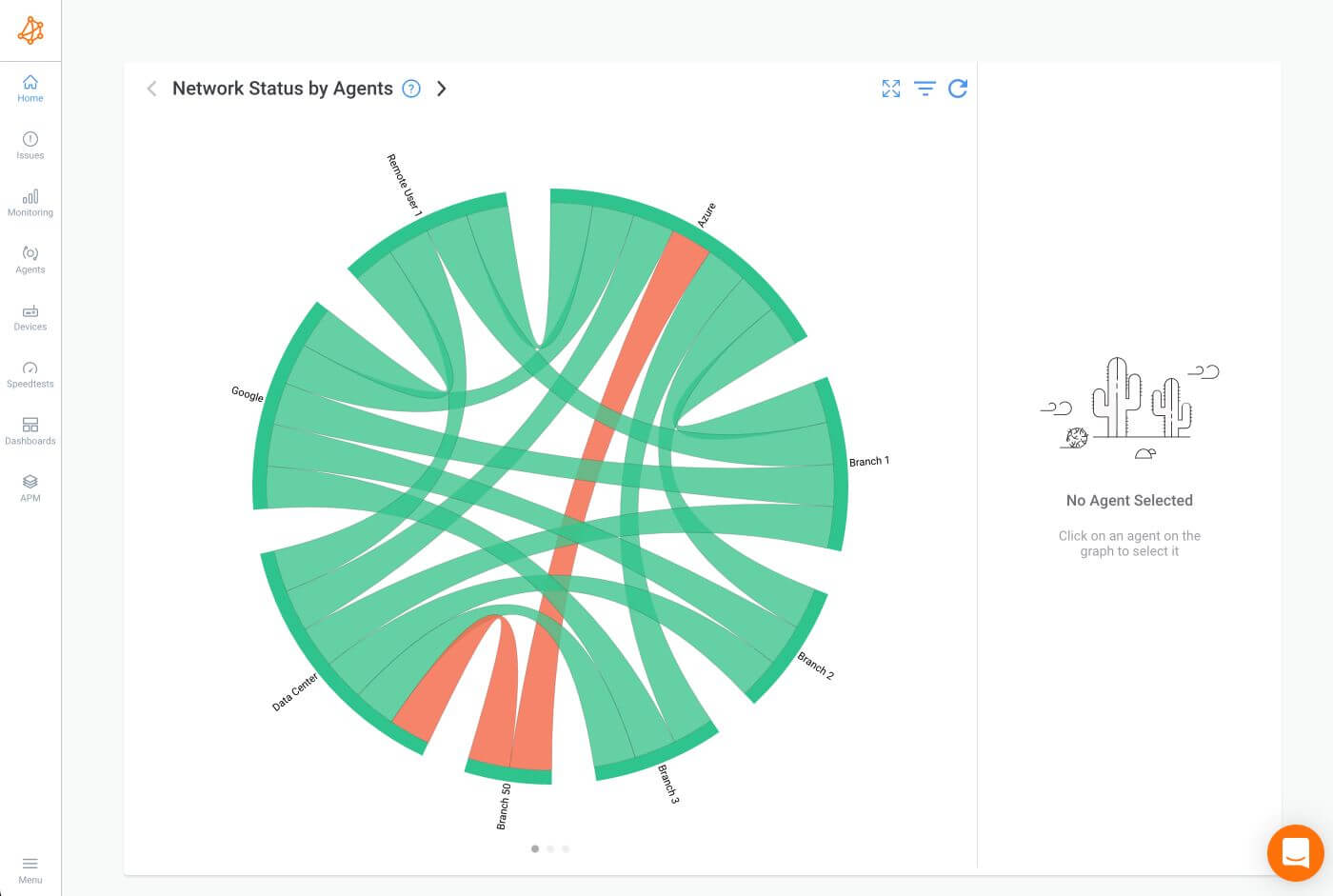
Once you’ve set up your Monitoring Agents, they will start measuring key network metrics like jitter and collecting data, which you can easily analyze on Obkio’s Network Response Time Graph.
Identify and measure jitter anywhere in your network, especially jitter affecting VoIP and UC applications, with updates every minute. You can also further drill down to identify where exactly the VoIP jitter is happening and start troubleshooting network issues.

We’ll dive into this a little more later on in the article but, when you’re measuring VoIP jitter, it’s important to understand how much jitter can affect VoIP performance. In VoIP communications, acceptable levels of jitter are generally defined by industry standards and best practices. However, what is considered "acceptable" can vary depending on the specific requirements of the application and the tolerance levels of the users.
As a general guideline:
1. Acceptable Jitter:
- For most VoIP applications, an acceptable jitter level is typically around 30 milliseconds or lower. This ensures that the variation in packet arrival times is minimal, resulting in good call quality.
- In situations where VoIP is used for casual conversations or non-critical communication, slightly higher jitter levels (up to 50 milliseconds) may still be acceptable without significantly affecting the user experience.
2. High Jitter:
- High levels of jitter can start to degrade the quality of VoIP calls. Jitter above 50 milliseconds may lead to noticeable disruptions, including choppy or distorted audio.
- In professional or business environments, where communication clarity is crucial, a jitter level exceeding 50 milliseconds is generally considered high and may require attention.
It's important to note that these are general guidelines, and the specific requirements for acceptable jitter can vary based on the nature of the VoIP application, the sensitivity of the users, and the overall network conditions.
Besides monitoring and identifying VoIP jitter itself, another way to proactively identify network issues affecting VoIP applications is to measure VoIP Quality. VoIP Quality refers to the clarity, reliability, and overall performance of voice calls made over a VoIP system.
Obkio’s Network Monitoring tool continuously monitors VoIP quality using a standardized rating system called MOS (Mean Opinion Score), which rates the quality of a voice call on a scale of 1 to 5. MOS scores are calculated based on subjective ratings from human listeners who rate the call quality based on factors such as clarity, background noise, and echo.
Since many people are not very familiar with the MOS Score and the interpretation of MOS in VoIP Quality, Obkio redesigned the MOS Score graph to create the VoIP Quality graph. Obkio’s MOS VoIP Quality graph categorizes, for every minute, the MOS Call Quality as
- Best
- High
- Medium
- Low
- or Poor

The exact MOS Voice Quality Score is always available in the graph tooltip.
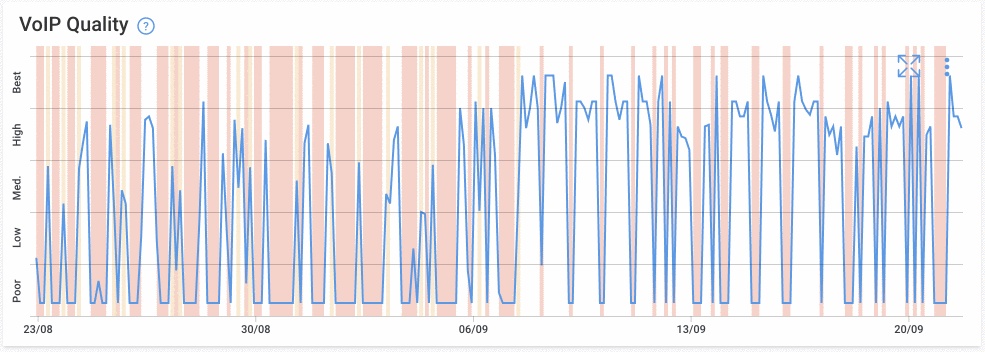
Obkio's capabilities extend beyond real-time monitoring, allowing users to set alerts for VoIP jitter and analyze historical VoIP jitter measurements.
By leveraging Obkio's alerting and historical analysis features, users can proactively address issues related to VoIP jitter. Setting alerts ensures that deviations from acceptable jitter levels are promptly identified, while historical analysis provides a retrospective view for informed decision-making and long-term optimization strategies.
- Choose jitter as the specific metric for which you want to set alerts.
- Set thresholds for acceptable and high levels of jitter based on your specific requirements. This ensures that Obkio will trigger alerts when jitter exceeds predefined limits.
- Specify how you want to be notified when an alert is triggered. Obkio supports various notification methods, including email alerts or integrations with other communication tools like Teams and Slack.
- Obkio will continuously monitor jitter levels and send alerts when deviations from the set thresholds are detected.
- Navigate to the historical data section on the Obkio dashboard.
- Choose the desired time range for historical analysis. Obkio allows you to view data over specific hours, days, or even weeks.
- Obkio provides graphical representations of jitter trends over the selected time range. Visualizing this data helps in understanding patterns and identifying recurring issues.
- Analyze the historical data to identify peak periods of jitter and any recurring trends. This insight can be valuable for troubleshooting and optimizing your network.
- Obkio allows users to export historical data for VoIP jitter, enabling more in-depth analysis using external tools if necessary.
Experiencing choppy audio or robotic voices during VoIP calls? These immediate fixes can reduce jitter and restore call quality in minutes.
Power cycle your network equipment to clear temporary congestion and reset network connections. Unplug your router and modem for 30 seconds, then plug them back in. This simple reset often resolves jitter caused by memory leaks or connection buildup.
Streaming services, file downloads, cloud backups, and video uploads consume bandwidth and create network congestion. Close Netflix, YouTube, Dropbox, OneDrive, and torrent clients before VoIP calls. Check Task Manager (Windows) or Activity Monitor (Mac) to identify applications using excessive bandwidth.
Wireless connections introduce interference and signal fluctuations that cause jitter. Connect your VoIP device directly to your router using an Ethernet cable. Wired connections provide consistent packet delivery and eliminate Wi-Fi-related jitter issues.
Internet service provider outages or maintenance can cause network instability. Visit your ISP's status page or call their support line to verify service quality in your area. Run a speed test at speedtest.net to check for unusual latency or packet loss.
Outdated VoIP applications contain bugs that impact call quality. Update Zoom, Microsoft Teams, RingCentral, or your VoIP phone firmware to the latest version. Software updates often include jitter buffer optimizations and codec improvements that reduce packet timing variations.
If jitter persists after these fixes, you need comprehensive network monitoring to identify deeper issues like:
- QoS misconfigurations requiring router settings adjustments
- Insufficient bandwidth requiring service upgrades
- Network congestion requiring traffic management
- Hardware failures requiring equipment replacement
Use network monitoring tools to measure actual jitter levels and pinpoint the exact source of call quality problems.
In the world of Voice over Internet Protocol VoIP, making sure our calls are crystal clear is a top priority. To get there, it's all about understanding the quirks and nuances of VoIP jitter. We're diving into the nitty-gritty of this journey by first learning to recognize the signs – those little hints that tell us something might be up.
Once we've got those down, we'll roll up our sleeves and run some tests, because figuring out what's going on under the hood is key.
When left unaddressed, VoIP jitter can manifest in various symptoms that impact the overall quality of voice communication. Recognizing these common symptoms is pivotal for diagnosing and troubleshooting jitter-related issues effectively.
- Choppy or Distorted Audio:
One of the hallmark symptoms of VoIP jitter is choppy or distorted audio during calls. Jitter disrupts the consistent delivery of voice packets, leading to irregularities in the audio stream. Users may perceive interruptions, pauses, or garbled speech, resulting in a compromised communication experience.
- Inconsistent Call Quality:
VoIP calls affected by jitter often exhibit inconsistencies in call quality. Users may notice fluctuations in audio clarity, with moments of pristine sound interleaved with periods of reduced quality. This inconsistency can be frustrating and challenging for users to adapt to during conversations.
- Packet Loss and Call Drops:
Severe jitter can contribute to packet loss, where voice packets fail to reach their destination. This can result in call drops or unexpected disconnections. Identifying instances of packet loss is crucial in understanding the severity of jitter-related issues and their impact on call reliability.
- Variable Delays in Audio Playback:
Jitter introduces variable delays in the playback of audio, causing unnatural pauses in conversations. Users may experience instances where the expected rhythm of communication is disrupted, leading to difficulties in understanding and responding promptly.
- Out-of-Sequence Packet Arrival:
Excessive jitter can cause voice packets to arrive out of sequence at the receiving end. This leads to the incorrect reconstruction of the audio stream, resulting in confusion and further degradation of call quality. Detecting out-of-sequence packet arrival is pivotal for diagnosing jitter-related issues accurately.
- Increased Latency:
Jitter is often associated with an increase in latency, contributing to delays in communication. Users may perceive a lag between speaking and hearing the response, making real-time conversation challenging. Monitoring latency alongside other symptoms is integral to a comprehensive diagnosis.
- User Frustration and Dissatisfaction:
The cumulative impact of jitter symptoms contributes to user frustration and dissatisfaction with the VoIP service. Recognizing user feedback and complaints about call quality issues is a crucial element in diagnosing the prevalence and severity of jitter-related issues.
- Monitoring Tools Alerts:
Network monitoring tools, such as Obkio, may provide network monitoring alerts and notifications specifically related to jitter. Paying attention to these alerts can assist in proactively identifying and addressing jitter-related issues before they escalate.
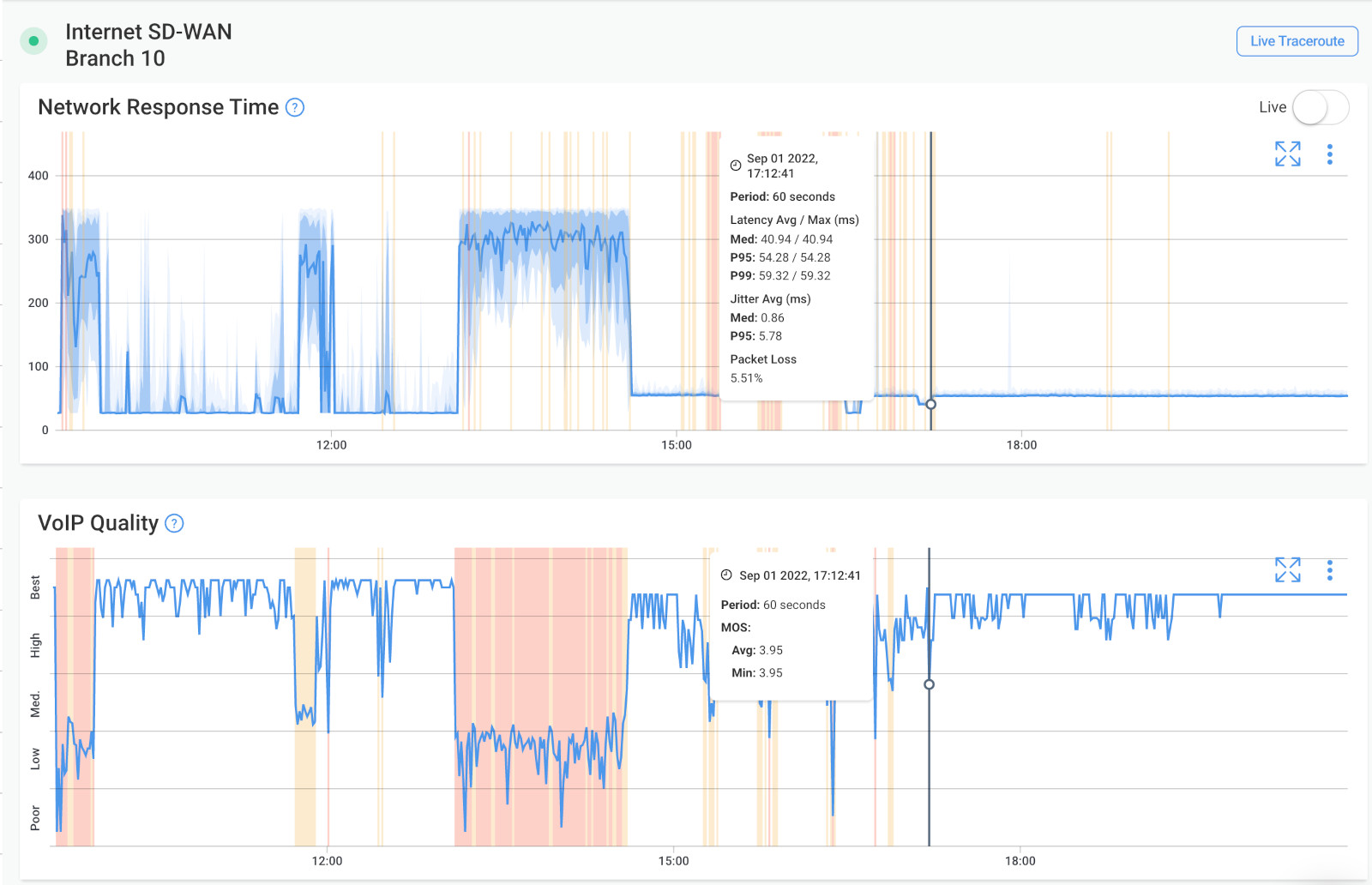
Identifying common symptoms of VoIP jitter is a fundamental step in diagnosing and troubleshooting related issues. By recognizing these indicators, network administrators can take informed actions to optimize network conditions, implement jitter buffering, and enhance the overall reliability of VoIP communication.
VoIP jitter tests combine a variety of strategies like real-time monitoring, network path assessment, buffer analysis, QoS metrics, historical trend analysis, and user feedback. By adopting these strategies, network administrators can effectively identify and diagnose VoIP jitter issues, paving the way for targeted optimizations and enhanced call quality.
Packet Timestamp Analysis: Conducting jitter tests involves analyzing packet timestamps to measure the variation in the arrival times of voice packets. Timestamps are crucial for calculating the jitter metric, providing insights into the consistency of packet delivery.
Real-time Monitoring Tools: Utilize real-time monitoring tools, such as Obkio, to perform continuous jitter tests during live VoIP calls. These tools offer instant visibility into jitter levels, enabling administrators to detect variations and anomalies that may affect call quality.
Traceroute and Path/ Network Visualization: Perform traceroute analyses to identify the network path taken by VoIP packets. Visualize the network path to pinpoint potential bottlenecks, routers, or switches that may contribute to jitter. To do this more easily, you can utilize Obkio’s Free Visual Traceroute tool.
Bandwidth and Latency Assessment: Assess the available bandwidth along the network path, as inadequate bandwidth can lead to congestion and increased jitter. Analyze latency levels at different network points to understand the delay introduced during packet transmission.
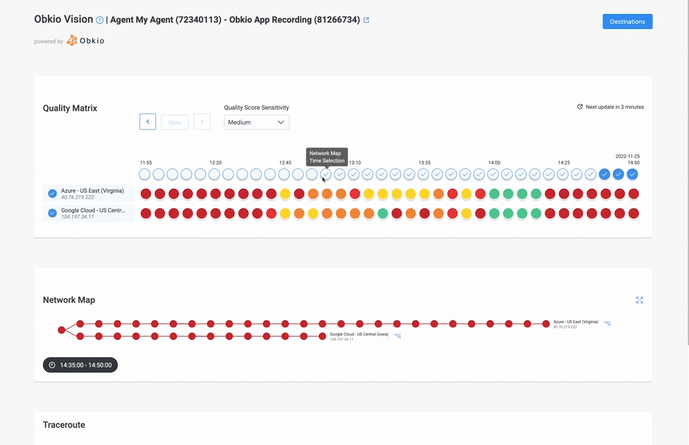

Jitter Buffer Size Examination: Investigate the jitter buffer size within VoIP devices or applications. Adjust the jitter buffer size to optimize its capacity for smoothing out variations in packet arrival times.
Buffer Delay Metrics: Monitor buffer delay metrics to understand how effectively the jitter buffer compensates for jitter. An excessively small or large buffer may impact call quality, and adjustments should be made accordingly.
Prioritization and Traffic Management: Implement Quality of Service (QoS) measures to prioritize VoIP traffic over the network.
Ensure that VoIP packets receive preferential treatment to minimize the impact of competing data traffic.
QoS Dashboard Analysis: Leverage QoS dashboards provided by network monitoring tools to assess key metrics, including jitter, packet loss, and latency.
Analyze QoS data to identify trends and patterns, aiding in the diagnosis of VoIP jitter issues.
Long-Term Jitter Patterns: Explore historical jitter trends over extended periods to identify recurring patterns. Historical analysis helps in understanding whether jitter issues are sporadic or chronic, guiding long-term optimization strategies.
Comparative Analysis: Compare jitter data with other network metrics, such as packet loss and latency, to identify correlations. This comparative analysis provides a comprehensive view of network performance factors contributing to jitter.
User Surveys and Feedback: Gather feedback from VoIP users through surveys or direct communication. User insights can complement technical analyses, helping to understand the real-world impact of jitter on their communication experience.
Simulated Load Testing: Conduct simulated load tests to simulate high network traffic conditions and observe the behaviour of VoIP calls under stress. Simulated testing can reveal how the network responds to increased demand and whether jitter issues emerge during peak usage.
Optimize VoIP performance with QoS implementation. Explore best practices for QoS for VoIP, overcome challenges, and elevate clarity with Obkio's NPM tool.
Learn more

When it comes to VoIP, the term "jitter" carries significant weight, influencing the very essence of communication. This section delves into the dual facets of VoIP jitter – its profound impact on call quality and the intricate anatomy that shapes its manifestation. So you’ll have the knowledge you need to not only recognize its effects on VoIP communications but also understand the underlying mechanisms that give rise to this disruptive force.
Understanding the consequences of jitter is essential for appreciating its impact on VoIP quality. The effects of jitter include:
1. Choppy and Distorted Audio
Jitter disrupts the smooth delivery of voice packets, leading to irregularities in audio playback. This manifests as choppy or distorted audio, where fragments of the conversation may be lost or played back out of order. Users on both ends of the call experience a compromised audio experience, making communication challenging.
2. Call Drops and Disconnects
Severe jitter can contribute to call drops and unexpected disconnections. When jitter becomes excessive, it may cause the VoIP system to lose synchronization, resulting in dropped calls. This is especially problematic in professional settings where uninterrupted communication is crucial.
3. Decreased Call Clarity
Consistent call clarity is a hallmark of effective VoIP communication. Jitter introduces fluctuations in voice packet arrival times, leading to inconsistencies in call clarity. Users may notice variations in audio quality, ranging from moments of pristine clarity to periods of muffled or garbled speech.
4. Frustrating User Experience
The cumulative impact of jitter contributes to a frustrating user experience. Users may find it challenging to follow conversations, leading to misunderstandings and reduced overall satisfaction with the VoIP service. In business environments, this frustration can hinder productivity and collaboration.

Understanding how jitter manifests in VoIP communications is crucial for diagnosing and addressing issues. In the following scenarios below, jitter becomes noticeable during a VoIP call:
Variable Delays in Audio Playback: Jitter manifests as variable delays in the playback of audio. Users may experience instances where the audio is delayed, leading to unnatural pauses in the conversation. This variability disrupts the expected rhythm of communication.
Out-of-Sequence Packet Arrival: Jitter can cause voice packets to arrive out of sequence at the receiving end, also called packet reordering. This results in the reconstruction of the audio stream in the wrong order, causing confusion and distortion in the conversation.
Audio Artifacts and Glitches: During periods of heightened jitter, users may encounter audio artifacts and glitches. These anomalies can take the form of clicks, pops, or brief interruptions in the audio stream, further compromising the overall call quality.
As we unravel the impact of jitter on VoIP quality and understand how it manifests, we equip ourselves with the knowledge needed to identify and address jitter-related issues. In the upcoming chapters, we will explore monitoring tools and effective troubleshooting strategies to enhance the overall resilience of VoIP communication.
And now, the moment you’ve all been waiting for; saying goodbye to VoIP Jitter (at least for now).
Fixing VoIP jitter isn't just about solving problems. It's like a two-step dance. First, you've got proactive moves – setting up a strong network that's ready to handle anything, lowering the chances of jitter causing trouble. Then, there are the reactive steps – giving admins the right tools to face jitter head-on during actual calls, and making sure your VoIP chats stay smooth and top-notch.
Staying ahead of potential jitter issues involves adopting proactive measures that contribute to a resilient and high-performing network.
Take a proactive stance by prioritizing VoIP traffic through Quality of Service (QoS) strategies. Ensure that voice packets enjoy a fast lane on the network to minimize jitter.
Traffic Prioritization:
- Implement QoS strategies to prioritize VoIP traffic over the network.
- Ensure that voice packets receive preferential treatment to minimize the impact of competing data traffic.
Bandwidth Management:
- Optimize available bandwidth by appropriately configuring QoS settings.
- Allocate sufficient bandwidth to VoIP traffic to prevent congestion and reduce the likelihood of jitter.
Strengthen your network infrastructure to combat potential jitter issues. Configure routers and switches for optimal VoIP traffic handling, and consider hardware upgrades for improved performance.
Router and Switch Configuration:
- Configure routers and switches to prioritize real-time VoIP traffic.
- Adjust settings to minimize buffering and ensure timely delivery of voice packets.
Upgrading Hardware:
- Consider upgrading network hardware, such as routers and switches, to handle increased VoIP traffic efficiently.
- Up-to-date hardware can contribute to lower latency and reduced jitter.
Fine-tune your jitter buffers for proactive jitter management. Adjusting buffer sizes and implementing dynamic management strategies contribute to a smoother VoIP experience.
Adjusting Buffer Size:
- Optimize the size of jitter buffers within VoIP devices or applications.
- Fine-tune buffer settings to strike a balance between smoothing out jitter and minimizing latency.
Dynamic Buffer Management:
- Implement dynamic buffer management that adapts to changing network conditions.
- Allow the jitter buffer to adjust its capacity based on real-time requirements.
Jitter buffers solve VoIP quality problems by storing incoming voice packets temporarily before playing them back in correct sequence. When packets arrive at irregular intervals due to jitter, the buffer holds them briefly and releases them at consistent timing, transforming choppy audio into smooth conversation.
Think of a jitter buffer like a playlist queue: packets arrive at unpredictable times, but the buffer reorders them and plays them back at the correct pace, masking network timing inconsistencies from users.
When your VoIP device receives voice packets, the jitter buffer performs three critical functions:
1. Packet Collection & Reordering Voice packets arrive with timestamps indicating their correct sequence. The jitter buffer collects these packets and reorders them based on timestamps before playback, preventing audio from playing out of sequence. If packet 5 arrives before packet 3, the buffer waits for packet 3 and plays them in the correct order.
2. Controlled Delay Introduction The buffer introduces a small, consistent delay (typically 30-200ms) to accommodate packet timing variations. This delay creates a window for late-arriving packets to reach the buffer before playback begins. The delay trades minimal latency for significantly improved audio quality.
3. Dynamic Size Adjustment Modern jitter buffers automatically adjust their size based on network conditions. When jitter increases, the buffer expands to hold more packets. When jitter decreases, the buffer shrinks to minimize delay. This dynamic management optimizes the balance between call quality and latency.
Jitter buffer configuration directly impacts VoIP call quality:
Small Buffer (30-50ms):
- Minimizes delay for natural conversation flow
- Best for stable networks with low jitter
- Risk: Late packets get discarded, causing audio dropouts
Medium Buffer (50-100ms):
- Balances quality and delay for most business environments
- Handles moderate jitter without noticeable lag
- Recommended for typical office networks
Large Buffer (100-200ms):
- Accommodates high jitter on unstable networks
- Prevents packet loss but introduces noticeable delay
- Users may experience awkward conversation pauses
Static Jitter Buffers Fixed buffer size regardless of network conditions. Simple to implement but inefficient—oversized buffers add unnecessary delay on good networks, while undersized buffers fail on poor networks.
Dynamic Jitter Buffers (Adaptive) Automatically adjust buffer size based on real-time jitter measurements. Modern VoIP systems use adaptive buffers that:
- Monitor packet arrival patterns continuously
- Expand when detecting increased jitter
- Shrink during stable network periods
- Optimize the delay-quality tradeoff automatically
Most professional VoIP platforms (Zoom, Teams, RingCentral) use adaptive jitter buffers by default.
Jitter buffers solve one problem (choppy audio) while creating another (increased latency). Understanding this tradeoff helps optimize settings:
Too Small: Packets arrive after playback begins, causing gaps and robotic audio. Buffer can't compensate for jitter variations.
Too Large: Excessive delay makes conversation feel unnatural. Users talk over each other or experience awkward pauses.
Optimized: Buffer size matches network jitter levels, providing smooth audio with minimal perceptible delay.
For networks with consistent jitter below 30ms, a 50-70ms buffer typically provides optimal results. Networks with variable jitter benefit from adaptive buffers ranging 70-150ms.

Most VoIP systems allow buffer configuration through:
VoIP Phone Settings: Access web interface or phone menu to adjust buffer size (min/max values). Increase buffer if experiencing choppy audio, decrease if calls feel delayed.
VoIP Application Settings: Softphone applications (Zoom, Teams) typically use automatic buffer management. Advanced settings may allow manual override for specific network conditions.
PBX/Server Configuration: Administrators can set system-wide jitter buffer policies. Configure different buffer sizes for internal calls (smaller) versus remote/mobile users (larger).
SIP Trunk Settings: Adjust buffer parameters at the trunk level to optimize for specific carrier networks or geographic locations with known jitter characteristics.
Jitter buffers compensate for timing variations but cannot fix:
- Severe packet loss (>3%): Missing packets create gaps buffers cannot fill
- Excessive jitter (>100ms): Buffer delay becomes unacceptable for real-time conversation
- Insufficient bandwidth: Buffers cannot create data that never arrives
- Network congestion: Buffers smooth timing but cannot increase capacity
If optimizing jitter buffers doesn't resolve quality issues, the underlying network problem requires fixes like QoS implementation, bandwidth upgrades, or infrastructure improvements.
Track these metrics to evaluate jitter buffer effectiveness:
Buffer Underruns: Occur when packets arrive too late for playback. High underrun rates indicate buffer is too small for network jitter levels.
Buffer Overruns: Happen when buffer fills completely and discards packets. Suggests excessive jitter or packet loss overwhelming buffer capacity.
Average Delay: Measure latency introduced by buffer. Target under 100ms for professional communication.
Jitter Absorption Rate: Percentage of jitter variations successfully masked by buffer. Aim for 95%+ absorption during normal operation.
Network monitoring tools measure these metrics continuously, alerting administrators when jitter buffers cannot adequately compensate for network conditions.
Zoom jitter causes audio to sound robotic, choppy, or delayed during video conferences. When jitter exceeds 30ms on Zoom calls, participants experience stuttering audio, voice cutting in and out, and difficulty following conversations.
Zoom uses adaptive jitter buffers that automatically adjust to network conditions. However, when your network experiences high jitter, even Zoom's built-in compensation can't maintain clear audio quality. Zoom's codec attempts to smooth packet timing variations, but severe jitter overwhelms these mechanisms.
During a Zoom call, click the connection indicator (green, yellow, or red signal bars) in the top-left corner. Poor connection quality indicates potential jitter problems. Check Zoom's audio statistics by navigating to Settings > Statistics during a call to view real-time latency and jitter measurements.
For continuous monitoring, use Obkio Network Performance Monitoring to track jitter levels between your network and Zoom's servers 24/7. Obkio measures jitter every 500ms, detecting issues before they affect live meetings. Set up monitoring agents at your office locations to measure actual jitter to Zoom data centers, receiving alerts when jitter exceeds 30ms so you can troubleshoot proactively rather than during important client calls.
Adjust Zoom's Audio Settings:
- Enable "Original Sound" for better audio processing (Settings > Audio > Show in-meeting option to "Enable Original Sound")
- Disable "Suppress Background Noise" which can interact poorly with jitter
- Turn off HD video to reduce bandwidth consumption
Network-Level Fixes:
- Close other applications using bandwidth during Zoom calls
- Connect via Ethernet instead of Wi-Fi
- Configure your router's QoS settings to prioritize Zoom traffic (TCP/UDP ports 8801-8810)
- Reduce Zoom video quality to 360p if bandwidth is limited
Zoom-Specific Requirements: Zoom requires less than 40ms jitter for optimal performance. Target jitter below 30ms for professional meetings. Use network monitoring tools to continuously measure jitter between your network and Zoom's servers.
Learn to monitor Zoom network performance to find Zoom jitter, Zoom packet loss & “Your Internet Connection is Unstable” Zoom performance issues on calls.
Learn more

Microsoft Teams jitter manifests as echo, delayed responses, or audio that sounds like participants are underwater. Teams is particularly sensitive to jitter because it transmits both audio and real-time collaboration data simultaneously.
Teams uses dynamic bandwidth allocation and adaptive jitter buffers up to 200ms. The platform automatically adjusts audio codecs (SILK and G.722) based on network conditions. However, when jitter exceeds 30ms, Teams degrades call quality by reducing audio bitrate, causing muffled or compressed sound.
Microsoft recommends:
- Excellent quality: Jitter below 30ms
- Acceptable quality: Jitter between 30-50ms
- Poor quality: Jitter above 50ms requires immediate troubleshooting
Teams provides real-time network quality indicators during calls. A yellow or red connection bar indicates jitter or packet loss affecting call quality.
Access Teams call quality metrics:
- During a call, click your profile picture > Settings > Devices
- After a call, go to your profile picture > Settings > Calls > Call History
- Select a recent call to view detailed quality metrics including jitter, packet loss, and latency
Teams administrators can access the Call Analytics dashboard in the Teams Admin Center for organization-wide jitter monitoring across all users.
Teams Application Fixes:
- Update Teams to the latest version (jitter buffer improvements released regularly)
- Disable GPU hardware acceleration (Settings > General > uncheck "Disable GPU hardware acceleration")
- Turn off incoming video during audio-only calls
- Close Teams notifications and background processes
Network Configuration:
- Prioritize Teams traffic using QoS policies for UDP ports 3478-3481 and 50000-50019
- Ensure sufficient bandwidth: 1.2 Mbps upload/download for 1:1 HD calls, 1.5 Mbps for group calls
- Implement Microsoft's recommended QoS DSCP markings (Audio = DSCP 46)
- Use Microsoft's Network Planner tool to assess bandwidth requirements
Teams-Specific Monitoring: Enable Teams Network Assessment Tool to test jitter before important meetings. This built-in tool simulates Teams calls to identify potential jitter issues before they affect real conversations.
For ongoing production monitoring, Obkio's Microsoft Teams Monitoring feature provides continuous jitter measurements with MOS score tracking, showing exactly how network jitter translates to Teams call quality degradation.

RingCentral jitter causes dropped calls, one-way audio, and delays between speaking and hearing responses. As a cloud-based business phone system, RingCentral requires consistent network performance to maintain professional call quality.
RingCentral uses sophisticated jitter buffers and packet loss concealment algorithms to mask network inconsistencies. The platform employs the Opus codec for voice calls, which adapts to varying network conditions. However, jitter above 30ms degrades RingCentral's ability to deliver clear audio, especially during call transfers and conference calls.
RingCentral specifies network requirements for optimal performance:
- Jitter: Less than 30ms for high-definition voice quality
- Packet Loss: Less than 1%
- Latency: Less than 150ms round-trip time
- Bandwidth: 100 Kbps upload/download per concurrent call
RingCentral provides call quality feedback after each call. If you're experiencing poor quality:
- Check the RingCentral app's connection status indicator
- Run RingCentral's built-in Network Connectivity test (Settings > Audio > Test Network Connection)
- Review call logs in the RingCentral Admin Portal for quality metrics
Common symptoms of RingCentral jitter include:
- Callers complaining they can't understand you
- Audio cutting in and out during active calls
- Delayed dial tone or slow call setup
- Frequent disconnections during peak business hours
RingCentral Application Settings:
- Update RingCentral desktop and mobile apps to latest versions
- Switch audio codecs in Settings (try G.722 if Opus shows issues)
- Disable echo cancellation if experiencing audio quality problems
- Reduce video quality during RingCentral Video meetings
Network Optimization for RingCentral:
- Configure QoS to prioritize RingCentral traffic (UDP ports 8000-8999, 16384-16482)
- Whitelist RingCentral's IP ranges in firewall rules
- Implement SIP ALG (Application Layer Gateway) settings on routers, or disable if causing issues
- Use RingCentral's recommended DSCP markings: EF (46) for voice packets
RingCentral-Specific Solutions:
- Deploy RingCentral Edge to optimize network routes to RingCentral data centers
- Use RingCentral's bandwidth calculator to verify adequate capacity
- Consider RingCentral's MPLS options for guaranteed call quality
- Enable RingCentral's Quality of Service reports for ongoing monitoring
Hardware Recommendations: Use RingCentral-certified IP phones and headsets for consistent performance. Certified devices include optimized jitter buffers and codec support specifically tuned for RingCentral's infrastructure.
Implement continuous network monitoring between your locations and RingCentral's data centers using Obkio's synthetic monitoring. Deploy monitoring agents that send test packets to RingCentral servers every 500ms, measuring jitter, latency, and packet loss in real-time. Monitor jitter specifically to RingCentral's server IPs to identify issues before they affect business calls. Set alerts for jitter exceeding 30ms to proactively address quality degradation.
Obkio's VoIP monitoring provides:
- Historical jitter trends showing patterns during business hours vs. off-peak times
- Correlation between network jitter and RingCentral call quality issues
- Visual traceroutes pinpointing where jitter originates in the network path
- MOS score calculations predicting call quality based on measured jitter levels
- Multi-site monitoring comparing RingCentral performance across office locations

VoIP jitter is the variation in packet arrival time during voice calls, measured in milliseconds. When voice data packets travel across a network at inconsistent intervals—some arriving faster, others slower—you experience jitter. This timing variation causes choppy audio, robotic voices, and delays during VoIP calls.
VoIP jitter is caused by:
- Network congestion: High traffic causing packet delays at routers and switches
- Insufficient bandwidth: Too many applications competing for limited network capacity
- Packet loss: Missing data packets forcing retransmissions
- Wireless interference: Signal fluctuations on Wi-Fi networks
- Poor QoS configuration: VoIP traffic not prioritized properly
- Routing inconsistencies: Packets taking different network paths with varying delays
Acceptable jitter for VoIP is 30 milliseconds or less. Jitter below 20ms provides excellent call quality, while 20-30ms maintains good quality. Jitter between 30-50ms causes noticeable audio issues requiring monitoring. Jitter above 50ms results in poor call quality with choppy audio and requires immediate troubleshooting.
To fix VoIP jitter:
- Implement QoS: Prioritize VoIP traffic on your router to ensure voice packets receive preferential treatment
- Upgrade bandwidth: Ensure sufficient capacity for concurrent VoIP calls (100 Kbps per call minimum)
- Optimize jitter buffers: Configure buffer size to match network jitter levels (50-150ms range)
- Use wired connections: Replace Wi-Fi with Ethernet cables to eliminate wireless interference
- Reduce network congestion: Close bandwidth-heavy applications during calls
- Update equipment: Replace outdated routers and switches that can't handle VoIP traffic efficiently
VoIP jitter is measured by calculating the variance in packet arrival times using timestamps. Network monitoring tools send test packets at regular intervals (typically every 500ms) and measure the difference between expected and actual arrival times. The measurement is expressed in milliseconds (ms), representing the average deviation in packet timing.
Latency is the total time for a packet to travel from sender to receiver (one-way delay), while jitter is the variation in that delay between packets. A call can have consistent 100ms latency with zero jitter (smooth audio) or inconsistent 50-150ms latency with high jitter (choppy audio). Both affect VoIP quality, but jitter specifically causes timing irregularities that disrupt conversation flow.
Yes, severe jitter can cause dropped calls. When jitter exceeds 100ms, VoIP systems may lose synchronization between endpoints, resulting in call disconnections. High jitter also correlates with packet loss, and when packet loss exceeds 3%, many VoIP systems automatically terminate calls to prevent poor user experience.
A jitter buffer is a temporary storage mechanism that holds incoming voice packets before playing them back in correct sequence. The buffer introduces a small delay (30-200ms) to compensate for timing variations, collecting packets and releasing them at a steady rate. This transforms irregular packet arrival into smooth audio playback, masking network jitter from users.
Jitter above 50ms is generally too much for professional VoIP communication. At this level, users experience choppy audio, robotic voices, and conversation delays. Most VoIP platforms (Zoom, Teams, RingCentral) specify maximum thresholds between 30-50ms, beyond which call quality degrades significantly. Critical jitter levels above 100ms make VoIP calls nearly unusable.
Yes, jitter affects video calls even more severely than voice-only calls. Video conferencing requires consistent packet delivery for both audio and video streams. High jitter causes audio-video synchronization issues (lip-sync problems), frozen video frames, and pixelated images. Video calls typically require jitter below 30ms for smooth performance.
Insufficient bandwidth increases jitter by causing network congestion. When bandwidth is saturated, packets queue at network devices, arriving at irregular intervals. Each VoIP call requires approximately 100 Kbps of dedicated bandwidth. Without adequate capacity, multiple simultaneous calls compete for resources, creating the packet timing variations that manifest as jitter.
Yes, network monitoring tools like Obkio continuously measure VoIP jitter in real-time. These tools send synthetic traffic every 500ms to measure actual network conditions, displaying jitter levels on dashboards with minute-by-minute updates. Real-time monitoring detects jitter spikes immediately, triggering alerts when thresholds are exceeded so administrators can troubleshoot before users experience problems.
MOS (Mean Opinion Score) measures overall VoIP call quality on a 1-5 scale, incorporating jitter alongside latency and packet loss. High jitter directly reduces MOS scores: jitter below 20ms typically produces MOS scores of 4.0-4.5 (excellent), while jitter above 50ms drops MOS below 3.0 (poor quality). Network monitoring tools calculate MOS scores automatically based on measured jitter levels.
QoS (Quality of Service) significantly reduces jitter but doesn't eliminate it completely. QoS prioritizes VoIP packets over other network traffic, ensuring voice data gets preferential treatment at routers and switches. This minimizes queuing delays and packet timing variations. However, QoS cannot compensate for insufficient bandwidth, packet loss, or network congestion beyond the router's control.
Test VoIP jitter by:
- Deploy network monitoring agents at key locations (offices, data centers)
- Run continuous measurements sending packets every 500ms to VoIP servers
- Analyze jitter metrics on monitoring dashboards showing real-time and historical data
- Conduct VoIP quality tests during peak usage hours to identify congestion patterns
- Use platform-specific tools like Zoom's connection quality indicator or Teams Call Analytics
- Measure to actual VoIP servers (Zoom, Teams, RingCentral IPs) for accurate production results
The optimal jitter buffer size depends on network conditions: 30-50ms for stable networks with low jitter, 50-100ms for typical business networks with moderate jitter, and 100-200ms for unstable networks with high jitter. Modern VoIP systems use adaptive buffers that automatically adjust size based on real-time jitter measurements, balancing audio quality against conversational delay.
Well, there you have it – our journey through the twists and turns of VoIP jitter. We've uncovered the mysteries, spotted the signs, and armed you with strategies to keep your conversations crystal clear. But hey, troubleshooting is a journey, not a one-stop destination. So, as you continue fine-tuning your VoIP experience, remember: every challenge is a chance to refine, and every hiccup is an opportunity to make your calls even smoother.
Let’s recap of key strategies for VoIP Jitter:
Proactive Strategies:
- Optimize Quality of Service (QoS) for prioritizing VoIP traffic.
- Enhance network infrastructure, configuring routers and switches for optimal performance.
- Fine-tune jitter buffers, striking a balance between size and dynamic management.
Reactive Steps:
- Leverage real-time monitoring tools for instant insights into jitter levels.
- Implement adaptive codecs to dynamically adjust to varying network conditions.
- Build network redundancy and failover mechanisms for uninterrupted communication.
To truly master VoIP jitter and ensure an unparalleled communication experience, take the next step with Obkio's Network Performance Monitoring (NPM) tool. This powerful solution goes beyond monitoring — it empowers you to identify, troubleshoot, and optimize your network for optimal VoIP performance.

Why Obkio's NPM Tool?
- Real-Time Insights: Get instant visibility into jitter levels and network conditions during live VoIP calls.
- Proactive Alerts: Be notified the moment the jitter exceeds predefined thresholds, allowing for immediate troubleshooting.
- Comprehensive Analysis: Dive deep into historical data, explore trends, and gain valuable insights into your network's performance.
- User-Friendly Interface: Obkio's intuitive interface ensures ease of use, making network monitoring and troubleshooting a seamless experience.
Take Control with Obkio's NPM Tool Today! See how Obkio's NPM tool can transform your network management, eliminate VoIP jitter, and pave the way for consistently exceptional communication.
In the dynamic world of VoIP, mastering jitter is not just a solution; it's a journey. Let Obkio be your guide to uninterrupted, high-quality communication.

Happy troubleshooting, and may your next conversation be as clear as day!


























 Obkio Blog
Obkio Blog



